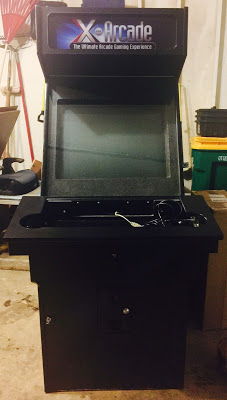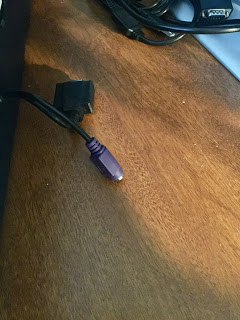Of course this is a big and very heavy machine which meant I had to rent a truck to pick it up, so although it was a dollar to buy there were going to be expenses to get it. When I finally got to his house he told me that he didn’t even want a $1 for it but just wanted to get it out of his garage so his wife could finally park her car in it, so it went from being a $1 to free. My son and I loaded it up and did the even harder job of unloading it in my garage on the other end. Now that is where you could assume the story would end, but actually I’ve found that it’s a lot more complicated than that, and in a way that’s where my story begins.
The Tankstick:
The X-Arcade cabinet is more or less built to go with the X-Arcade Tankstick which is a large two player arcade set up with a trackball in the middle. Although, X-Arcade offers smaller controllers the gap in the controller tray of the cabinet pretty much requires the Tankstick, otherwise you’d have to deal with the controller floating around in the tray. The Tankstick sells for $150 (sale price for now) from X-Arcade directly, and to be honest it sells for way higher than that through other outlets, even eBay. Having just sold a few items on eBay myself, I took the money from that and bought the Tankstick, which arrived only a few days later via FedEx. The massive box arrived on my doorstep the Friday of the same week I got the cabinet. The massive outer box measures a bit over two feet long, over a foot wide, and a foot deep with the controller inside only slightly smaller than those dimensions.
The Tankstick itself has a bit of weight to it making it easy to see why some gamers buy these sticks ala carte, since they would sit firmly on any surface for hours of arcade like play. On the back, there are two sets of double ended cables, one set for plugging into a computers serial port with a USB conversion attachment for power, and the second end for plugging into an old school PS/2 keyboard. The other set is the USB for the trackball, with the second end a PS/2 adapter for connecting into an older computer. Compared to an actual arcade cabinets control wires, this is actually a simple setup, only a little more complicated than hooking up a modern desktop PC.
When X-Arcade sells its arcade cabinets it sells them with the Tankstick, and computer already installed so had I bought this cabinet new, about a $2500+ proposition, buying, programming and installing this stick would not be my problem, but with that said it is. The first night I got the stick I unpacked it and bought it to my kitchen counter to play with for a bit. It powered up just fine when plugged into my laptops USB, and even the trackball worked as second mouse on the laptop. The only issue was that the Tankstick had to be programmed, and this is a bit of an issue. For whatever reason the folks at X-Arcade determined that rather than allow their devices to be programmed via USB through a modern computer, they instead wanted their sticks programmed with old PS/2 keyboards. By PS/2 I’m not talking about PlayStation 2, but rather the purple mini-S-video looking type of adaptor that computer manufactures stopped using about 10 years ago. The instructions play it off as if its something simple you will just have laying around, but to be honest in a era when people are choosing less and less to have desktops, and if they do are choosing to go with wireless keyboards it makes little sense to require a PS/2 keyboard to program this thing. If X-Arcade sold PS/2 keyboards to add to your order for programming it would probably piss me off too, but they don’t even offer that so instead you find yourself combing thrift stores for one. Oh, and by the way those PS/2 to USB converters they have out won’t work either. To say the least I found myself combing a Salvation Army store one evening to find one, luckily I did.
With that said it comes down to programming the stick, which is a nerve wracking experience since the actual inputs aren’t exactly clear and are based on your emulation program. I’ll come back to this later.
Heart Like a Computer:
With the original PC taken out, a pre-programmed Dell from what I understand, I have to choose a system of my own to be the heart of this arcade emulator. I have four choices:
Pine64- A Pine64 is a small computer like that of a Raspberry Pi. The Pine64 was actually the first 64-bit entry into the realm of mini-computers beating the Raspberry Pi 3 by some months. I picked mine up through the Pine64 Kickstarter last year and just got it back in May. I didn’t exactly know what I wanted to do with it, but I’ve had it in mind to use it for MAME emulation, or powering a multiple Jamma arcade cabinet, both ideas of which I back seated shortly after receiving the Pine64 board.
The Old Laptop in the Closet – In the back of the office closet lie some electronic items that currently have no home or use in our house. We hang on to them because they do have the potential to one day be useful again. About two years ago my father just dropped off an old Compaq laptop, explaining he had gotten a new one. My oldest son quickly claimed it to play Minecraft on, but within two months we took it away from him since he had downloaded numerous viruses and Trojans on to it in search of questionable Minecraft mods he saw on YouTube. One of these malicious items briefly screwed up the computers WiFi, and my wife spent days fixing it to get it up and working again, but after that it went into storage. Emulators don’t exactly need a lot of computing power making the old WiFi capable Vista based computer a viable option.
The Old Laptop in the Closet 2 – Yes, there is a second back there an old one of mine that works but has some functionality issues. It’s actually an old “movie laptop”, which was a short lived fad in the late 00’s, these where laptops with large screens, Dolby sound, and sub-woofers meant to act as on the go home theatre systems. I actually used it on a trip once and it was fairly impressive to watch DVD’s on in a hotel room.
My WiFi-less Laptop – My newest laptop fell victim to Windows 10, when a Windows 10 update in early 2016 screwed up both the WiFi and ethernet drivers, and it’s been impossible to fix on my own since. I’ve considered bringing it in to be fixed, but between my phone, iPad, and Desktop I’m not sure how badly I need a laptop right now. Anyway, it has Windows 10 and is pretty fast, just the lack of WiFi that bothers me.
The overall goal with these systems is to install an emulator “frontend” on one of them and then hook it up the the cab’s monitor, and sound, and then hook the Tankstick up to it. The issue is that there are several frontends out there, and many MAME emulation programs, and its key to find the right one to get this system to work fairly seamlessly. In my next entry I will discuss frontends, and how it lead to my computer selection.




Leave a Reply